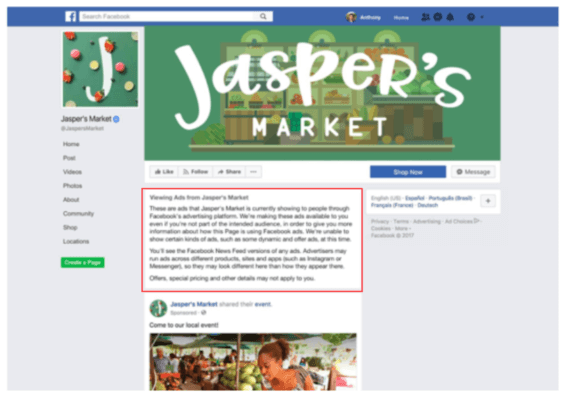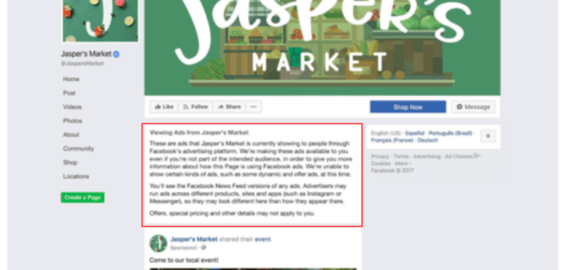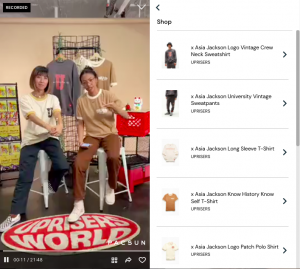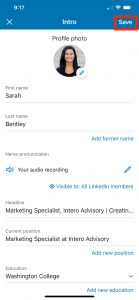As Facebook begins rolling out its ‘View Ads’ tab on Pages, columnist Laura Collins discusses the ramifications for advertisers and how the new disclosure will affect ad transparency.

One of the foundations of Facebook advertising is the ability to segment your audience to serve relevant, tailored creative to different users.
The ad you serve to a 25-year-old woman could be very different from the one a 50-year-old man sees, specifically because you want to communicate with them in different ways. And previously, there was no way for that woman to know what you were saying to men. But all that is changing.
Facebook last month announced drastic changes to its rules around ad transparency, which I’ll explore in more detail here.
What changes are coming?
Starting this month in a small test in Canada, users visiting a business’ page will be able to select an option to “View Ads.” This will allow them to view all ads being served for the business represented on that page — including those on Messenger and Instagram — regardless of whether they fall into the audience originally intended to view them or not. All ad buys will have to be associated with a page, which will prevent advertisers from skirting this disclosure.

For most pages, users will not be able to see any detail on impressions, clicks or targeting related to those ads, and they’ll only see them in the news feed environment. They won’t know if that ad generated one impression on the Facebook Audience Network, or 1 million on Instagram. But they’ll get a full overview of that page’s paid ad content.
Why are these changes happening?
Facebook has come under enormous pressure from governments and the public alike to provide more transparency around its advertising since it was revealed that ads served by Russia-backed pages reached 10 million Americans in the run-up to last year’s election.
Initially, Facebook denied such a thing could’ve happened, then said it had happened but wouldn’t have had much impact, and finally conceded that “though the volume of these posts was a tiny fraction of the overall content on Facebook, any amount is too much.”
Which indeed it is. In a situation reminiscent of the golden age of espionage (with a modern techie twist), memes and satire were inevitable. But it’s very troubling to think that one country could influence the outcome of another’s election using platforms that are part of the fabric of our everyday lives.
But nobody likes change!
Well, in this case, the public and government probably do. Governments need to protect the foundations of democracy, and people don’t like feeling as if they’ve been duped. This move should hopefully help to appease both.
But understandably, some advertisers and agencies are nervous. If you’ve invested time and money in a sophisticated creative strategy aimed at serving highly relevant ads to multiple, granular audiences, what if a competitor just visits your page and steals all your ideas?
Well, in reality, that’s no different from what could occur across other channels. If you run a TV or print ad, it’s out there. Everyone can see it, and there’s no taking it back or reserving it for specific audiences.
This change by Facebook will simply place its advertising under the same levels of scrutiny. And with Facebook’s assurances that no targeting or impression data will accompany ads, there’s probably little a competitor could gain from such a search.
There were more serious considerations for heavily regulated industries such as finance. Where an ad had been deemed misleading and paused, could it still be viewed and continue to mislead people? But Facebook confirmed that only active ads being served for a page will be viewable to users.
The exception to this is political pages. With politics at the heart of this whole issue, Facebook will be demanding even higher levels of transparency from these advertisers. As the test rolls out to the US next year in time for the federal elections, users will be able to view data on targeting, spend and impressions, as well as historical ads, not just active ones. Such a change should reassure anyone who’s felt misled by fake news and dodgy politicians lately.
(Note: Twitter is doing something similar to offer transparency around advertising.
What to expect next
As the test in Canada progresses, one would hope Facebook will be… transparent about their new transparency rules. It’ll be interesting to hear if such visibility has any impact on advertisers thanks to rife theft of ideas.
Personally, I’m curious to hear how many users will actually choose the “View Ads” option. I’d predict that just knowing that option is there will be enough to keep most people happy and that it’ll be a very small percentage who make the effort to go trawling through a page’s whole back catalog.
While tweaks are to be expected, these changes will be rolled out globally in some form over the course of 2018. There are still some unanswered questions, but anything that could prevent future election interference and boost people’s trust in the platform should only be viewed as a good thing.
Opinions expressed in this article are those of the guest author and not necessarily Marketing Land. Staff authors are listed here.
Marketing Land – Internet Marketing News, Strategies & Tips
(26)









